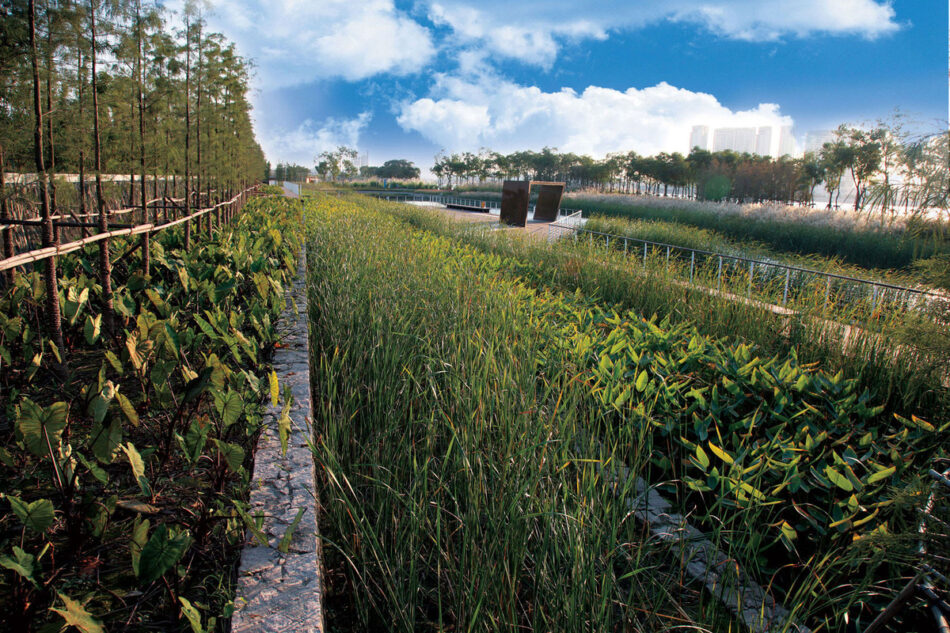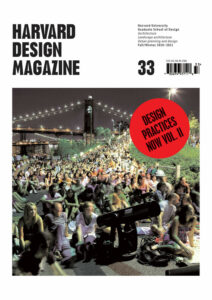Kongjian Yu: Turenscape Landscape Architecture, Urban Design, Architecture, Beijing
Turenscape’s largest applied project is a master ecological plan for Beijing, but on a national scale our ideas about ecological security patterns (which I developed in my doctoral dissertation at Harvard’s GSD) have been integrated by the Ministry of Land and Resources into its planning efforts. The goal is to protect China’s most sensitive ecological zones and create a strategy for land conservation and development, including headwater conservation, soil erosion prevention, storm-water management and flood control, work against desertification, plus conservation of biodiversity and cultural heritage. To reach an ideally high level of security, we argue that it is necessary to protect 75% of national land from urbanization and to build an ecological infrastructure/network to safeguard natural processes and cultural/historical values. We aim to remove concrete channelized embankments, restore wetlands, and try to store stormwater on site. Several cities are working with us to attain these goals, although the vast majority continues in their old and destructive ways. In Beijing, our ecological plan is an official policy, but it is not yet enforced.
We are designing an eco-city for 100,000 people in Wuhan (Hebei Province) for a private developer, with some help from Mark Johnson, the head of Civitas Urban Design, Planning and Landscape Architecture in Denver. We do everything from landuse and infrastructure planning to schematic design of individual buildings. Meanwhile, elsewhere in China we are designing some fifty parks focusing on ecological synthesis; we are also entering competitions in the United States, South Korea, and Spain. Our Houtan Park at the Shanghai 2010 Expo explores how landscape can be used as ecological infrastructure to clean water, and our well known Red Ribbon Park works to make a welcoming public place with the lightest, least intrusive possible touch on the land. The new catchphrase in China is “low carbon,” which we seek through low maintenance and low embodied energy in the materials. Although I have been promoting these matters for ten years, my firm has been thinking more deeply and carefully about them in the last three.
In Houtan Park, scientists measure the change in the river water that passes through it: Transversing 1.7 kilometers during a week, the water starts out at the lowest quality grade, lower-5, and improves to grade upper-3, so that 2,400 cubic meters per day can be used as non-potable water for the expo. This water improvement has received a lot of media attention, and the mayor of Shanghai said that he wanted to use this model for the city’s whole water system and to dechannelize all its rivers. But land managers in China don’t know how to care for riparian river corridors and instead concentrate on land scapes of ornamental flowers and reject “weeds.”
Turenscape’s influence has been on government decision-makers from the ministry level to that of mayors. I send mayors my book The Road to Urban Landscape and give lectures at meetings of mayors and city-level decision-makers at least ten times a year. I get more invitations than I can accept for public speaking and interviews by newspapers. At the Mayor’s Forum in Beijing, I lecture to about fifty mayors at least twice a year. Most of my clients are mayors. As one of two papers about urban plann ing and design, my lecture “Building an Ecological City” is included in a must-read textbook published by the National Library for ministry-level Chinese officials, and my paper about Zhongshan Shipyard Park, “The Culture Being Ignored and the Beauty of Weeds: The Regenerative Design of an Industrial Site,” is now part of the required middle-school text book in Jiangsu Province. I also drafted the industrial heritage protection declaration in China for the Department of Cultural Heritage; Shipyard Park is the first such protected site in China.
So our influence is significant and growing, but we’re still a long way from impacting most Chinese landscapes. Hydrological engineers who channelize rivers are still in control of water in the landscape, which is critical for national ecological security. Within landscape architecture departments in universities, I am a disapproved maverick, but my influence goes beyond those: Our work is better known in China than in the United States, but among landscape architects internationally it is perhaps appreciated more outside China.
It should not require fifty years to implement our national ecological security guidelines, because Chinese authorities can make things happen quickly by fiat. I have written a letter to the prime minister about our proposals, and received replies through the Ministry of Land and Resources and the Ministry of Housing and Urban-Rural Development.
We can’t always count our on landscapes being taken care of well or appropriately. Dedicated owners will take care of it, but our Red Ribbon Park is being added to inappropriately: A pedestrian bridge is being constructed across the river; rockery and piped-in music have been added. It is very difficult to change conventional cultural and aesthetic attitudes; this will take decades.
Here’s how I established the Graduate School of Landscape Architecture at Peking University and the Turenscape office: After completing my doctoral studies at the GSD, I worked for almost two years at the SWA Group in California. I then took a job as professor in the Department of Urban and Environmental Sciences at Peking University, where I set up a center for landscape architecture. One year later, I started Turenscape as a secondary job in order to practice what I preached and to support our students doing research. In 2003, I upgraded the center to the Graduate School of Landscape Architecture, and then I upgraded it again this year to the College of Architecture and Landscape Architecture, which combined the Center of Architecture and the Graduate School of Landscape Architecture; I am the founding dean of both. Peking University is mainly for arts and sciences. At first other schools at the university didn’t understand what we are doing; I had to convince them that landscape and urban design are crucial to our future. Turenscape has given me the chance to test my ideas and affect the real world.
After attending one of my lectures, people hired me to do projects, and the income allowed me to expand the business. At first it was only research projects, but then I asked clients to allow me to do the real project. Shipyard Park is my first seriously built work. In China we have no competitors in terms of size (we have over 500 professionals) and technological sophistication. Usually people call me because they know me, so they are not considering other designers. We usually don’t participate in competitions in China, except very important and serious ones like those for the Beijing Olympics and the Shanghai Expo. The norm in China is still the ornamental garden, and I am not invited to design those.
All the students in the school are doing only research projects in a separate area of our building—they are not involved in Turenscape’s design projects. We now have six Ph.D. students in science. So far Peking University gives credit only for research papers, not for design projects. Turenscape has a post-professional program for our employees, and this year, four or five will earn a professional degree. Each year we hire five to ten of my ex-students after they have completed their university research projects. Other former students are working in China both in practice as well as in academia, where, at other universities, they are establishing research institutes and promoting ecological design and planning.
Quite often I lose battles, and landscapes that I have opposed get built —the dreadfully sterile, empty, hard-surfaced, flower-bedded Beijing Olympic site is just one example. But most of my fights are not with ornamental gardeners but with hydrological engineers. Only engineers are allowed to do hydrological work; they have to follow unenlightened laws about what to do to prepare for twenty-, thirty-, and fifty-year floods. They are uninformed about ecology; they only calculate how water flushes, and they still pour tons of concrete on to the land. In the rare times when mayors take on the risks, regressive hydrological codes are ignored. The problem in China is that the profession is stratified. Hydrologists should be working within the landscape architecture profession.
One of the keys to improving landscape practices in China is changing national codes. There is no code that tells you how to do good stormwater management, how to pave and build roads, or how to use wetlands. Changing these codes could be very difficult because of entrenched interests in the status quo. Those that believe in us, like the Land and Resources ministry, are actually changing this kind of code. China’s huge problems will require huge responses.

